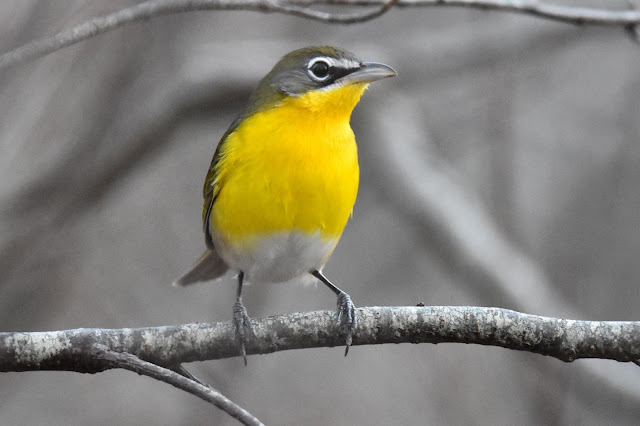Audubon reported seeing his first specimen in 1832. The species was first described in 1760 by Mathurin Jacques Brisson. Its name underwent various changes until 1802 when Francois Marie Daudin gave it the binomial name, Tyrannus savana.
Fork-tailed Flycatcher [Marbeth Wilson Photo]The bird in the above photos has been seen in the Hampstead area for the last two weeks of November, 2021. It is feeding on insects found around a pasture and houses and barns. It obviously is struggling to survive as noted in its ruffled plumage.
The Fork-tailed Flycatcher has a surprisingly small body, much smaller than the other kingbirds. It is the long tail that gives it its size. The bird measures 37 cm (14.5 in) in length and on seeing it, it appears to be mainly tail. The back is gray and the crown is black and the underparts are white. The tail is very long in an adult male, shorter in the female, is mainly black in colour and is beautifully forked. When I have seen this bird I wonder how it actually manages to manoeuvre that long tail. Males and females have similar plumage and juveniles resemble adults.
The Fork-tailed Flycatcher belongs to the Kingbird branch of the flycatcher family, Tyrannidae. Kingbirds are conspicuous birds which often perch on exposed perches from which they sally out to catch insects. There are 3 basic groups of Kingbirds - white-bellied, yellow-bellied and long-tailed. Adults in the group have a colourful, semi-concealed central crown patch and notches in their outer primaries. Obviously it is easy to tell the long-tailed group from other kingbirds. The yellow crown patch on the Fork-tailed Flycatcher is not easily seen.
Fork-tailed Flycatcher [Marbeth Wilson Photo]The photo above was taken in July in New Brunswick and shows an adult with a much shorter tail. This is likely a female or an adult which has moulted its tail feathers which are regrowing. The two photos above this photo were taken of a different bird in November and show a full adult plumage.
Fork-tailed Flycatchers seen here are easy to identify. There are two species one would have to distinguish them from. The Scissor-tailed Flycatcher also is a rare vagrant here and it also has a very long tail. It does not have the black cap, has an orangy-pink colour under its wings and its long tail shows a lot of white in the feathers. The other species is the Eastern Kingbird which shows a similar gray/white/ black pattern but it is much larger and does not have the long tail. Its tail is also white-tipped.
Since Fork-tailed Flycatchers are from South America, they are here in late fall thinking it is summer! What a shock it much be for a vagrant as our weather worsens. What brings these vagrants so far north? It is thought that their presence here is a result of overshooting their northward migration to breeding grounds in the tropics. Instead of stopping in northern South America or in Central American, they overshoot to some place in North America. Severe storms and strong winds undoubtedly also play a part. The sad part is that they probably do not know how to turn around and head back south.
Fork-tailed Flycatcher [Jim Carroll Photo]Fork-tailed Flycatchers prefer open habitat and low vegetation up to about 300 m elevation. Their nest is cup-shaped and built in trees. It is formed out of grass, plant fibres, leaves and bark shreds and lined with hair and down from seeds. Two to four white eggs marked with brown are laid and incubated for 14 to 17 days. The courtship behaviour of the male is interesting. He swirls, somersaults, twists and flips for his proposed mate. That must be interesting to see with that long tail!
This species is not very vocal. They produce a buzzy sound and a weak 'tic' sound in flight. A.C. Bent describes a behaviour worth noting (Life Histories of North American Flycatchers, Larks, Swallows, and Their Allies, Dover, 1963, p.81). This is a reference by Hudson from 1920; "They are not gregarious, but once every day, just before the sun sets, all the birds living near together rise to the tops of the trees calling to one another with loud, excited chirps, and then whirling about for a few moments, they precipitate themselves downwards with the greatest violence, opening and shutting their tails during their wild zig-zag flight, and uttering a succession of sharp, grinding notes. After this curious performance they separate in pairs, and perching on the treetops each couple utters together its rattling castanet notes, after which the company breaks up." Now, wouldn't that be something to see?
Fork-tailed Flycatchers feed primarily on insects. If insects are scarce they will feed on berries and small fruits. And what about that long tail? How do they actually survive with it? Apparently it is important to them. (One would assume so or they would not have evolved in that manner.) It actually helps them chase down insects. It allows them to turn quickly and thus catch more insects. Studies tell us they can actually reach speeds of 40 km/h (65 miles/h) and they can stop and turn very quickly using that special tail. That would indicate this is a hardy species and this is evident by their ability to stray so far from their normal range.
This year, 2021, we have had two Fork-tailed Flycatchers in New Brunswick; one in July and one in November. It is unlikely these are the same individual. We don't often get bird movement in an east-west direction. We don't know what happened to the July individual and we won't likely know what happens to the November bird.








